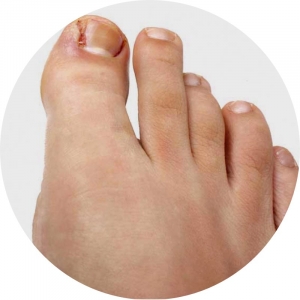Everything you need to know about ingrown toenails
What is an ingrown toenail?
An ingrown toenail occurs when a section of the toenail digs into the edge of the toe. This can cause pain from simple pressure; however, when the nail pierces the skin, the body reacts to this trauma and swelling, and pain occurs.
What does an ingrown toenail look like?
- The skin and tissue at the edge of the nail will become red, swollen and painful initially.
- If it is not treated early, then the redness will become more noticeable, and it may become hot with pus present.
- The image at the top of this page is of an ingrown toenail before it has become markedly infected.
Why do ingrown toenails occur?
There are various causes of ingrown toenails.
- Poor cutting technique. Ideally, the nails should be cut straight across and NOT cut down the sides
- Picking or tearing the nails. Tearing or cutting down the side of the nail can leave a spike of nail that can then pierce the skin.
- Trauma to the nail such as stubbing the toe.
- Tight shoes.
- Certain sports can push the nail in such as ballet.
- A major cause of ingrown toenails, especially ones that recur regularly is a nail that is too wide or curves too much. In this situation, the nail can dig into the skin as it grows naturally.
How do you avoid an ingrown toenail?
- Avoid cutting down the side of your nail; remember to cut the nail straight across.
- Do not pick the toenails
- Avoid tight shoes
- If you have curved or wide toenail see a podiatrist regularly for appropriate trimming.
Is an ingrown toenail an infection?
Ingrown toenails are not initially infected; it is the pressure and the bodies reaction to the nail piercing the skin that causes the swelling, redness and pain.
IT MUST BE REMEMBERED THE MAIN CAUSE OF AN INGROWN TOENAIL IS THE NAIL DIGGING INTO THE SKIN NOT THE INFECTION.
Once the nail has pierced the skin, this can then allow bacteria in, and a secondary infection can occur. This is often when the problem becomes rapidly more painful, much more swollen and usually has pus present.
Do ingrown toenails go away on their own?
If the ingrown toenail is minor and the nail has not pierced the skin then with rest and avoidance of tight shoes, it may settle down.
What is the non-surgical treatment for an ingrown toenail?
One of the initial steps is to avoid tight shoes; this will help with pain and potentially reduce the chance of it getting worse. To help soothe the pain and prevent infection salt water soaks can make a significant impact for little effort.
- Soak the foot in a clean basin of warm (not hot) water with two tablespoons of salt dissolved in it. Soak for approximately ten minutes.
- Apply antiseptic liquid, such as betadine liquid.
- Try to avoid covering the toe with plastic bandaids or anything tight.
- Do this at least once daily and twice if it is producing lots of exudate.
The above can be tried for a couple of days; however, if it does not settle or gets worse, then you need to see a podiatrist or podiatric surgeon. An attempt will be made to clear the side of the nail and removes the spike digging in.
Do in need antibiotics for an ingrown toenail?
If the ingrown toenail is at the early stages and it has not become infected then no. What is does need is for the spike of nail to be removed ASAP. Once the spike of nail is removed, continue with the above saltwater soaking routine, and it typically settles very quickly.
If it gets worse, more swollen, the redness is spreading and pus develops then it is becoming infected will probably need antibiotics. You may need to see your GP for this or a podiatric surgeon.
What about ingrown toenails and diabetes?
If you have diabetes, you may be at a higher risk of complications. You must take them seriously and see your GP, podiatrist or podiatric surgeon as soon as one develops. They will commonly require antibiotics, and if the ingrown toenail occurs regularly a minor procedure may be necessary to avoid future problems
When should I see a podiatric surgeon?
If the non-surgical treatment by your GP or podiatrist has not worked or the problem regularly returns, then a minor procedure carried out by a podiatric surgeon may be necessary.
Does the whole nail need to be removed?
Removing the whole is very rarely required. This was commonly done in the past. Due to the new procedures and the unecessary trauma, it causes it should be avoided except in certain rare situations when the condition has been present for years, or the swelling covers the whole nail
Ingrown Toenail Surgery and Recovery
When do I need surgery?
- If the condition does not settle with non-surgical treatment.
- If it keeps returning.
- If you need to see your podiatrist or GP regularly.
- If the infection will not settle.
- If antibiotics have not fixed the problem.
What types of surgery are available?
There are two types of surgery available:
A) The more invasive wedge resection, sometimes known as a “Sharp” procedure. This procedure is much more invasive than the more modern procedures. They usually require general anaesthetic and are carried out in a hospital.
B) The more modern procedure known as a Partial Nail Avulsion with phenolisation

What procedure is required?
In most situations, the more modern partial nail avulsion with phenolisation is the surgery of choice.
- It produces excellent results.
- Fixes the problem permanently.
- Pain-free procedure when done under local anaesthetic.
- Does not require hospitalisation.
- Can be done under local anaesthetic
- Rarely has complications.
In certain situations, when the skin on the side of the nail has become permanently enlarged, the more involves wedge resection may be necessary.
What is involved with surgery?
The procedure is carried out in the medical centre in Dr Lafferty’s rooms, although it can be carried out in the day surgery with general anaesthetic if preferred.
- A local anaesthetic is utilised, and complete numbness is guaranteed.
- Once numb the small offending section of the nail is gently removed, and a chemical is applied to the nail producing region.
- The area is flushed, and no stitching is required.
- The dressing is removed after 2- 4 days and a small bandage is changed daily at home for approximately two weeks.
- Regular shoes can be worn after approximately one week. This should prevent the re occurrence of an ingrown toenail.

When can I drive after the surgery?
The toe will be numb for approximately one hour, and driving is not recommended during this time. A lift home is advised after the surgery.
Typically the dressing will be on the toe for 2 to 4 days and usually does not interfere with driving, however in certain situations the dressing may have to be large and driving may need to be avoided for the first 2 to 4 days.
Can I have it done under sedation or general anaesthetic?
Yes, it can be done under sedation or general anaesthetic. In some situations, previous attempts by other health practitioners may have left a person “traumatised” by earlier efforts and may not want to be awake. This will require a trip to the day hospital; however, it will not require an overnight stay.
What to do if you have had failed surgery?
A large part of Dr Lafferty’s practise now involves revision surgery for failed previous surgery by another health practitioner. In most situations, the procedure is the same as a first attempt. The same excellent permanent success would be expected.
What complications can occur?
Modern ingrown toenail surgery is very safe, and complications are now rare, although there are certain risks that patients must be made aware of, regardless of the rarity.
Infections very rarely occur when carried out correctly.
The ingrown toenail can return, however, if carried out correctly this is very rare.
The risks of foot surgery are very similar to those risks posed by having other surgery, such as infection, unexpected pain, anaesthetic complications, and deep vein thrombosis.
There are also risks associated with having certain medicines during and after your surgery, such as the possibility of nausea and vomiting if carried out under sedation or general anaesthetic.
Risks associated with surgery are explained to the patient during their pre-operative consultation. You will have every opportunity to ask as many questions as you like during the consultation.
Useful resources:
The Australasian College of Podiatric Surgeons
https://www.acps.edu.au/
The American College of Foot and Ankle Surgeons
https://www.acfas.org/

